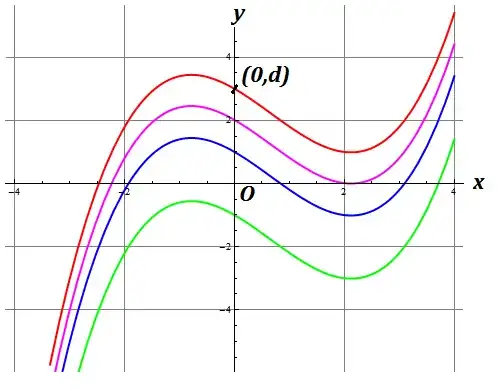If elementary differential calculus can be used we can take help of graph of cubic to obtain a single real root $x_r$.
The graph appears like a rocket course that initially begins to plummet for $a>0$ but recovers to rise again. ( For $a<0$ the order is reversed with first plummet, rise and plummet again).
In doing so the graph should keep $(y_{max}/y_{min})$ both above or both below the x-axis with a single intersection at $x_r$, so that their product is positive.
The constant coefficient $d$ influences by entire cubic graph $y$ shifting up or down, so I have included here elementary min/max differential calculus.
$$ y(x)=ax^4+bx^2+cx+d \tag 1$$
Its graph should cut x-axis only once. Maximum/minimum values $y(x_1), y(x_2)$ at roots $(x_1,x_2)$ of parabola are found by differentiation.
$$ \frac{dy(x)}{dx}=3ax^2+2bx+c=0 $$
$$(x_1,x_2)= \left(\frac{-b+\sqrt{b^2-3ac }}{3a},\frac{-b-\sqrt{b^2-3ac}}{3a}\right) $$
The clue to find determinant for single intersection $x_r$ of graph is when extrema are on same side of x-axis ( here red and green ), i.e., discriminant for single $x_r$
$$ \Delta= y(x_1)\cdot y(x_2)>0$$
For three intersections/real roots the discriminant
$$ \Delta<0$$
and for a single root and a double root that has tangential contact with x-axis we have
$$ \Delta=0$$
By simplification we find the discriminant
$$\boxed{\Delta=\frac{a(4c^3+27ad^2)+b(4b^2d -bc^2-18acd)}{27 a^2}}$$
It can be derived with Cardano formulae but believe it would be more cumbersome to go around and express it in terms of given $(a,b,c,d)$.

Plots generated for cubic coefficients $(a,b,c)=(.2,-0.4,-1)$, $d =(3,\approx 2.01213,1,-1)$ for four cubics shown above.
A a unique single root/ numerical solution of (1) can be obtained subject to condition $\Delta>0 $ satisfied by given coefficients
